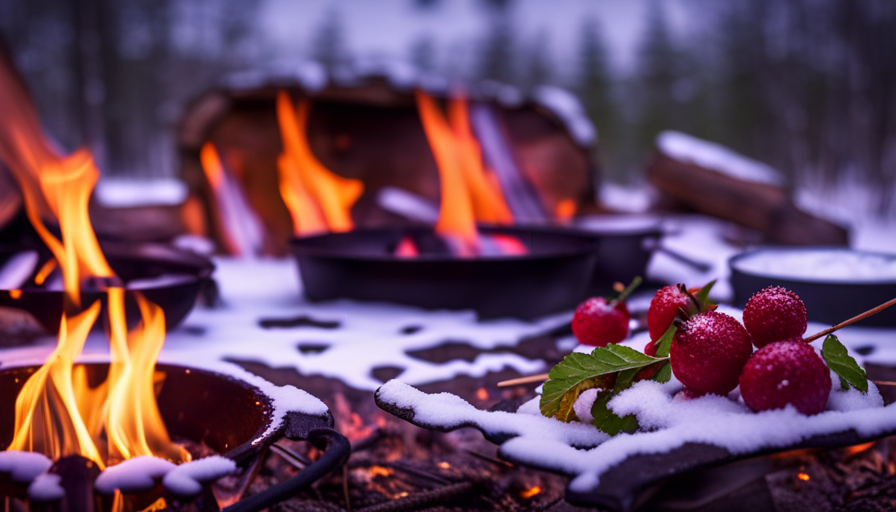Winter camping can be a thrilling and challenging experience for outdoor enthusiasts. As the temperature drops and the snow falls, it takes a special kind of skill and preparation to enjoy the great outdoors.
One of the best ways to add some comfort to a winter camping trip is by mastering the art of campfire cooking. Not only will it keep you warm and well-fed, but it can also be a fun and rewarding experience.
In this article, we will provide you with practical tips and gear recommendations for winter campfire cooking. Bryan Haines, co-founder of GudGear and a seasoned outdoor adventurer, shares his expertise on everything from building a proper fire to using a Dutch oven for slow-cooked meals.
Whether you are a novice or an experienced camper, his tips and recommendations will help you elevate your winter camping experience and impress your fellow adventurers with your cooking skills. Additionally, we will cover important safety tips that should always be followed to ensure a safe and enjoyable trip.
So, grab your gear and get ready to cook like a boss in the great outdoors!
Building the Fire
Despite potential challenges, such as wet wood or windy conditions, building the fire remains a critical aspect of successful winter campfire cooking, as it provides the necessary heat for cooking and creates a cozy atmosphere that evokes feelings of warmth and comfort amidst the cold winter air.
To start, gather dry firewood and kindling, and use a fire starter to ignite the fire. Building a log cabin fire provides a good coal base for cooking and helps to control the flames. In addition, it’s important to keep the fire contained using a fire ring or pit, and to avoid building fires under overhanging branches or near flammable materials.
When building a winter campfire for cooking purposes, it’s also important to consider the type of wood being used. Hardwoods, such as oak or hickory, burn longer and hotter, making them ideal for cooking. Softwoods, such as pine or cedar, burn faster and create more smoke, which can impact the taste of the food.
It’s also important to let the fire burn down to a bed of hot coals before cooking, as this provides a consistent and even heat source. By following these tips and techniques for building a winter campfire, campers can enjoy delicious and comforting meals in the great outdoors.
Cooking Methods
One-pot meals provide a low maintenance option for preparing food while enjoying the outdoors, and can be easily accomplished using a Dutch oven or suspended over flames using a cooking tripod.
Dutch ovens are versatile cast-iron pots that can be used to slow-cook meats, bake bread, and make stews and chili. They are perfect for winter camping as they retain heat longer than other cookware, making them ideal for cooking in cold temperatures. One-pot meals cooked in a Dutch oven also require less cleanup, which is a bonus when you’re in the great outdoors.
Suspended over flames using a cooking tripod, one-pot meals can be cooked in a similar manner, providing a delicious meal with minimal effort.
When it comes to cooking over a winter campfire, roasting is a fun way for kids to get involved in meal preparation. Hotdogs and sausages are easy to cook and are an ideal meal for kids. It’s a fun way to connect with nature and enjoy the simplicity of cooking over an open fire.
Additionally, roasting marshmallows is a classic camping tradition that should not be missed. Nothing beats the taste of a perfectly toasted marshmallow, and it’s a great way to end a day spent outdoors.
Cooking over a winter campfire can be a great way to bond with family and friends while enjoying the beauty of nature and delicious meals.
Campfire Safety
To ensure safe practices while enjoying the outdoors, it is important to follow basic campfire safety guidelines.
Checking the firewood before use is crucial to prevent the spread of fire and potential harm to individuals.
Using telescopic roasting sticks is also recommended, as they provide a safer distance between the individual and the fire.
Additionally, having a first aid kit on hand, with items such as burn cream, ice packs, and bandages, is crucial in case of emergencies.
Taking a first aid course before embarking on a camping trip can provide valuable knowledge in handling potential injuries and can also provide an opportunity to meet new camping buddies.
Basic common sense tips for campfire safety should also be followed, such as keeping a safe distance from the fire, never leaving the fire unattended, and avoiding flammable items near the fire.
It is also important to be aware of any fire restrictions in the area and to follow them accordingly.
By following these guidelines, individuals can enjoy a safe and enjoyable winter camping experience.

